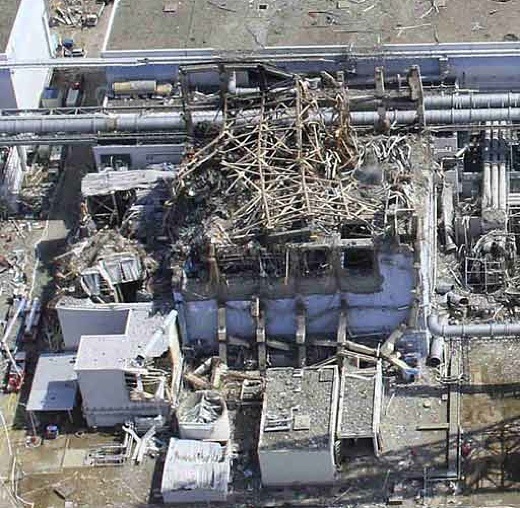SUBHEAD: Reactor #3 explosion evidence indicate a "prompt criticality". Japanese response is to underplay the dangers.
By Stoneleigh on 3 May 2011 for Automatic Earth -
(http://theautomaticearth.blogspot.com/2011/05/may-2-2011-fukushima-fallacies-fallout.html)

Image above: Wreckage of Fukushima Daiichi Reactor #3. From original article.
By Stoneleigh on 3 May 2011 for Automatic Earth -
(http://theautomaticearth.blogspot.com/2011/05/may-2-2011-fukushima-fallacies-fallout.html)

Image above: Wreckage of Fukushima Daiichi Reactor #3. From original article.
[IB Editor's note: This is only a portion of a longer article.]
The best interpretation of data and events at Fukushima is being provided by Arnie Gundersen at Fairewind Associates (see video below), a nuclear engineer of long experience. His most recent contribution puts the events of the last six seeks in stark perspective. He compares the explosive events at units 1 and 3, providing a very convincing case for the unit 3 detonation having resulted from a prompt criticality in the spent fuel pool.
Pieces of fuel rods have been discovered as much as two miles away, plutonium dust has been detected on site and uranium and americium powder has been detected as far away as the US, indicating the volatilization of nuclear fuel. The spent fuel at the plant is a major concern, with at least two spent fuel pool (at units 3 and 4) either damaged or destroyed. The pool at unit 3 contained almost an entire reactor core of spent fuel, and at unit 4 the total was even much higher - between two and three reactor cores.
Much of the building is missing (see above), enough for it to be impossible for the spent fuel pool to have survived. TEPCO data appears to suggest the reactor itself is intact, but the scale of the destruction must lead to some considerable doubt.
Pieces of fuel rods have been discovered as much as two miles away, plutonium dust has been detected on site and uranium and americium powder has been detected as far away as the US, indicating the volatilization of nuclear fuel. The spent fuel at the plant is a major concern, with at least two spent fuel pool (at units 3 and 4) either damaged or destroyed. The pool at unit 3 contained almost an entire reactor core of spent fuel, and at unit 4 the total was even much higher - between two and three reactor cores.
Much of the building is missing (see above), enough for it to be impossible for the spent fuel pool to have survived. TEPCO data appears to suggest the reactor itself is intact, but the scale of the destruction must lead to some considerable doubt.
Toshio Kosako, a government advisor on radiation safety, recently resigned in protest over the handling of the accident by the Japanese government.
Video above: Gundersen, of Fairwinds Associates, postulates Unit 3 explosion may have been a prompt criticality in fuel pool. From (http://vimeo.com/22865967).
Another senior advisor, Michio Ishikawa, the former head of the Japan Nuclear Technology Institute and an ardent supporter of the nuclear industry, also made dramatic claims contradicting the official version of the extent of the damage at Fukushima.In one of his most damaging charges, the adviser, Toshiso Kosako, drew attention to a recent government decision to allow children living near the crippled Fukushima Daiichi nuclear plant to receive doses of radiation equal to the international standard for nuclear power plant workers. That level is far higher than international standards set for the public. "I cannot allow this as a scholar," said Mr. Kosako, an expert on radiation safety at the University of Tokyo. He also blasted the government for what he said was a lack of transparency in releasing radiation levels around the Fukushima Daiichi plant, and for setting an overly high limit on radiation exposure for workers who have spent weeks struggling to keep the plant under control. Government advisory positions are considered prestigious, and it is highly unusual for an academic to quit one in protest.
I believe the fuel rods are completely melted. They may already have escaped the pressure vessel. Yes, they say 55% or 30%, but I believe they are all melted down. When the fuel rods melt, they melt from the middle part on down. I think the temperature inside the melted core is 2000 degrees to 2000 and several hundred degrees Celsius.
A crust has formed on the surface where the water hits. Decay heat is 2000 to 3000 kilowatts, and through the cracks on the crust the radioactive materials (mostly noble gas and iodine) are escaping into the air. Volatile gas has almost all escaped from the reactor by now.
The water [inside the pressure vessel] is highly contaminated with uranium, plutonium, cesium, cobalt, in the concentration we've never seen before. My old colleague contacted me and shared his calculation with me. At the decay heat of 2000 kilowatt... There's a substance called cobalt 60. Highly radioactive, needs 1 to 1.5 meter thick shields. It kills people at 1000 curies. He calculated that there are 10 million curies of cobalt-60 in the reactor core.
If 10% of cobalt-60 in the core dissolve into water, it's 1 million curies. They (TEPCO) want to circulate this highly contaminated water to cool the reactor core. Even if they are able to set up the circulation system, it will be a very difficult task to shield the radiation. It will be a very difficult work to build the system, but it has to be done. It is imperative to know the current condition of the reactor cores.
It is my assumption [that the cores have melted], but wait one day, and we have water more contaminated with radioactive materials. This is a war, and we need to build a "bridgehead" at the reactor itself instead of fooling around with the turbine buildings or transporting contaminated water.
Video above: Gundersen, of Fairwinds Associates, postulates Unit 3 explosion may have been a prompt criticality in fuel pool. From (http://vimeo.com/22865967).
.
No comments :
Post a Comment